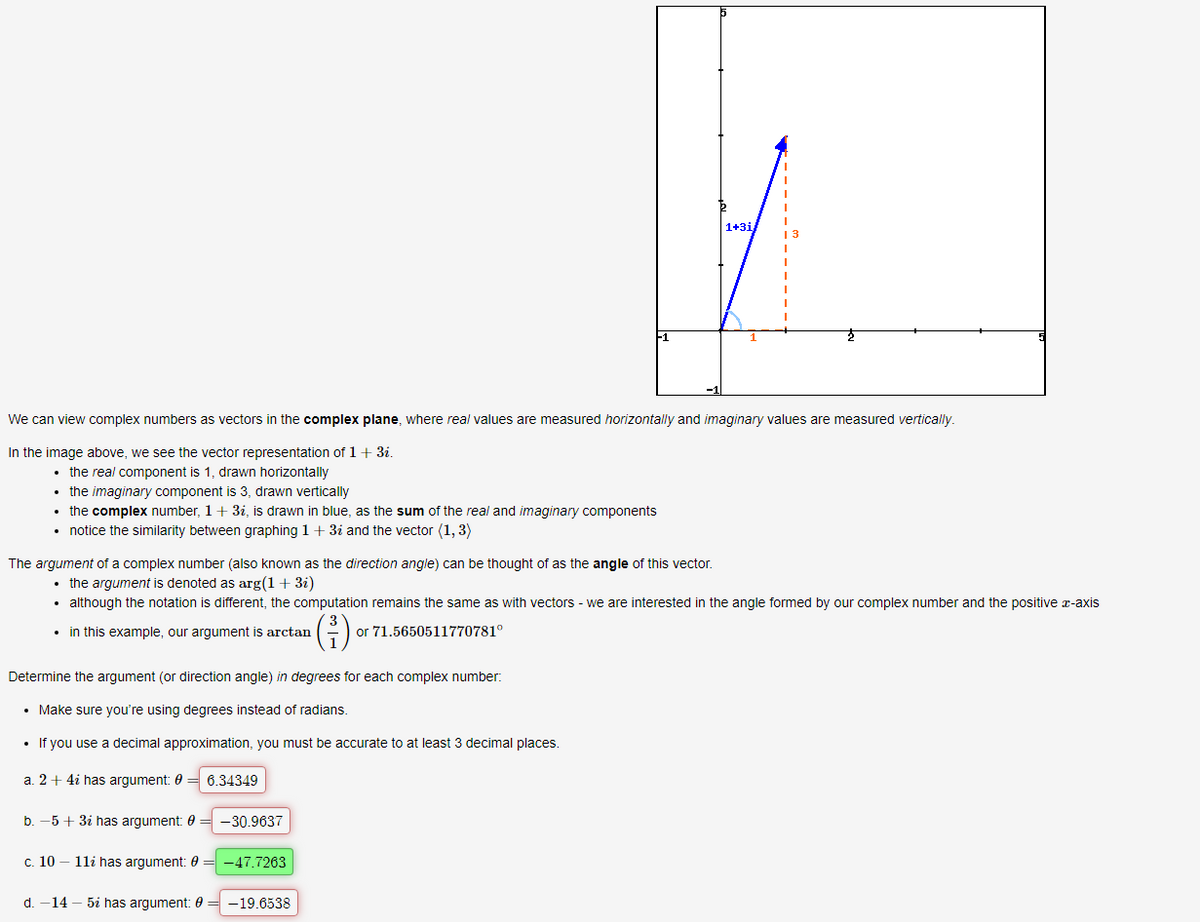I don't know why questions A B and D are wrong. If possible can you send me the correct way of working it out to get the answers, please? Thank you in advance
I don't know why questions A B and D are wrong. If possible can you send me the correct way of working it out to get the answers, please? Thank you in advance
Trigonometry (MindTap Course List)
10th Edition
ISBN:9781337278461
Author:Ron Larson
Publisher:Ron Larson
Chapter4: Complex Numbers
Section4.3: The Complex Plane
Problem 50E
Related questions
Question
I don't know why questions A B and D are wrong. If possible can you send me the correct way of working it out to get the answers, please? Thank you in advance.

Transcribed Image Text:1+3i
| 3
We can view complex numbers as vectors in the complex plane, where real values are measured horizontally and imaginary values are measured vertically.
In the image above, we see the vector representation of 1+ 3i.
• the real component is 1, drawn horizontally
• the imaginary component is 3, drawn vertically
• the complex number, 1+ 3i, is drawn in blue, as the sum of the real and imaginary components
• notice the similarity between graphing 1+ 3i and the vector (1, 3)
The argument of a complex number (also known as the direction angle) can be thought of as the angle of this vector.
• the argument is denoted as arg(1+ 3i)
• although the notation is different, the computation remains the same as with vectors - we are interested in the angle formed by our complex number and the positive x-axis
• in this example, our argument is arctan
or 71.5650511770781°
Determine the argument (or direction angle) in degrees for each complex number:
• Make sure you're using degrees instead of radians.
• If you use a decimal approximation, you must be accurate to at least 3 decimal places.
a. 2 + 4i has argument: 0 =
6.34349
b. -5 + 3i has argument: 0
-30.9637
c. 10 – 1li has argument: 0 = -47.7263
d. -14 – 5i has argument: 0
–19.6538
Expert Solution
This question has been solved!
Explore an expertly crafted, step-by-step solution for a thorough understanding of key concepts.
Step by step
Solved in 2 steps with 1 images

Recommended textbooks for you

Trigonometry (MindTap Course List)
Trigonometry
ISBN:
9781337278461
Author:
Ron Larson
Publisher:
Cengage Learning

Algebra and Trigonometry (MindTap Course List)
Algebra
ISBN:
9781305071742
Author:
James Stewart, Lothar Redlin, Saleem Watson
Publisher:
Cengage Learning

Algebra & Trigonometry with Analytic Geometry
Algebra
ISBN:
9781133382119
Author:
Swokowski
Publisher:
Cengage

Trigonometry (MindTap Course List)
Trigonometry
ISBN:
9781337278461
Author:
Ron Larson
Publisher:
Cengage Learning

Algebra and Trigonometry (MindTap Course List)
Algebra
ISBN:
9781305071742
Author:
James Stewart, Lothar Redlin, Saleem Watson
Publisher:
Cengage Learning

Algebra & Trigonometry with Analytic Geometry
Algebra
ISBN:
9781133382119
Author:
Swokowski
Publisher:
Cengage

College Algebra
Algebra
ISBN:
9781305115545
Author:
James Stewart, Lothar Redlin, Saleem Watson
Publisher:
Cengage Learning